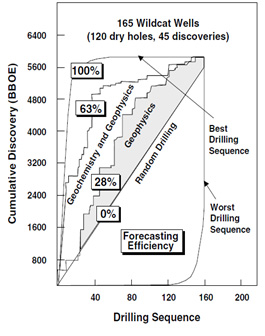Background
Petroleum geochemistry is the fruit of questions about the origin of hydrocarbons, and for the time being, its development has been closely linked to that of petroleum exploration. It is a young science, most of it having been acquired in less than 40 years. However, petroleum geochemistry nowadays plays an important role in the exploration and production of oil, and of fossil fuels in general.
The single most significant contribution of petroleum geochemistry to exploration efficiency is that it can be used to show genetic relationships among crude oils and source rocks. Geochemistry also increases petroleum exploration and production efficiency by accounting for many of the variables that control the volumes of petroleum available for entrapment (charge), including source-rock quality and richness, thermal maturity, and the timing of generation-migration-accumulation relative to trap formation. Geochemistry is most powerful when used with other disciplines, such as seismic sequence stratigraphy and reservoir characterization. Including geochemistry in prospect appraisal remarkably improves exploration efficiency. The research works show that forecasting efficiency based only on structural and reservoir data (e.g. geophysics) approximately doubles when geochemical charge and retention parameters are included in prospect evaluation. Costly exploration failures, such as the Mukluk OCS Y-0334 No. 1 well in Alaska (∼$140 million in 1983 dollars) are painful reminders that large structures indicated by seismic data may lack oil and gas due to geochemical charge factors.

Organic geochemistry is the study of organic substances in sediments and sedimentary rocks. It attempts to understand their composition, their origin, formation mechanisms, modes of deposition and distribution, as well as their relations with one another and with the mineral world.
Applications
Petroleum geochemistry improve the petroleum exploration and development efficiency by the following approaches, all of which are conducted by the Energy Researchers Ariana (ERA) Company:
- Source rock evaluation
- Oil-Oil correlation
- Oil-Source correlation
- Petroleum fingerprinting
- Chemometric assessment
- Hydrocarbon contamination evaluation
- Environmental studies
- Reservoir continuity assessment
- Partitioning of commingled production zones
- Characterizing origin and extent of tar formations (tar mats)
- Basin and petroleum system modeling
Analytical methods
- Rock-Eval 6 analysis
- HC generation kinetics characterization
- Soxhlet extraction
- Elemental analysis (EA)
- Liquid chromatography (LC)
- SARA fractionation
- Gas chromatography (GC)
- High resolution GC (HRGC)
- Pyrolysis-GC (Py-GC)
- GC-Mass spectrometry (GC-MS)
- Pyrolysis-GC-MS (Py-GC-MS)
- Bulk isotope analysis
- Compound specific isotope analysis (CSIA)
- Fourier transform infrared spectroscopy (FTIR)
- Organic petrography/petrology
- Maceral characterization
- Vitrinite reflectance (%Ro) measurement
Benefits
- A relatively cost effective method compared to other exploratory methods (e.g. geophysical surveys)
- Establishing a clear distinction between oil and gas bearing pay zones
- Relatively high exploration success rate (up to 68%)
- Requires small amounts of oil/rock samples for analysis and interpretation
